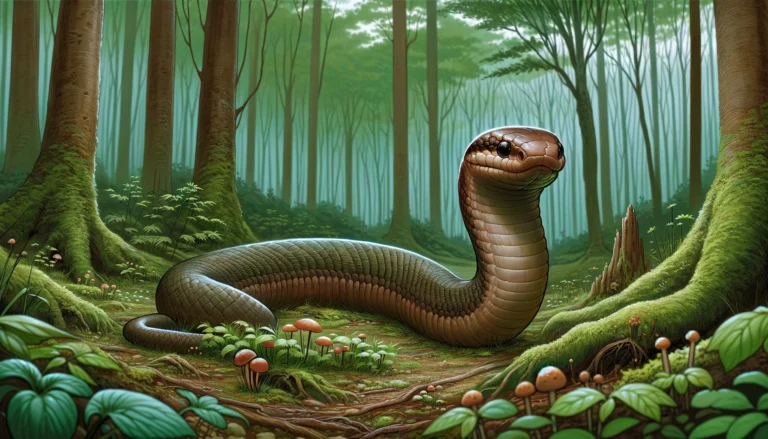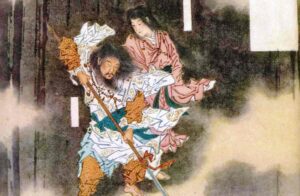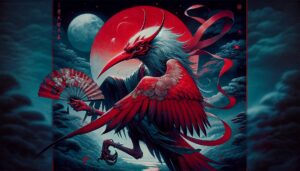Table of Contents
In the heart of Japan’s lush and mystical landscapes, where ancient forests and serene rivers intertwine, there exists a creature that has intrigued and baffled generations with its enigmatic presence – the Tsuchinoko. This peculiar and elusive serpent-like being has earned its place in the rich tapestry of Japanese mythology, capturing the imaginations of those who seek to uncover the truth behind its existence.
Origins
The Tsuchinoko, commonly called “bachi hebi” or “tsuchi hebi,” deeply roots itself in Japanese folklore. Its origins date back centuries, and both locals and enthusiasts of the unexplained have been captivated by its mysterious existence. The “Wamyo Ruijusho,” a Japanese dictionary from the Heian period (794-1185 AD), records its first mention. However, it was not until the Edo period (1603-1868) that the creature gained widespread recognition in both folk tales and written records. During this time, the Tsuchinoko began to establish itself as a truly captivating entity in Japanese mythology.
Physical Appearance

The Tsuchinoko, as described in Japanese folklore and reported sightings, exhibits varying features. It typically appears as a snake-like or lizard-like creature with the following characteristics:
Length: Tsuchinoko typically measure around 30 to 80 centimeters (approximately 12 to 31 inches) in length, making them shorter and more robust compared to typical snake species in Japan.
Body shape: It possesses a thick, fat body that people often describe as rounded or barrel-shaped, in contrast to the elongated and slender bodies of most common snakes.
Coloration: Reports of Tsuchinoko sightings suggest a range of colors, including brown, green, or reddish-brown. The specific coloration can vary from one individual to another.
The head of the Tsuchinoko is often depicted as larger in proportion to its body compared to typical snakes. It may also have distinctive features such as fangs or a forked tongue.
Movement: Although generally described as snake-like, the Tsuchinoko is said to move uniquely. Some accounts suggest that it can jump or hop like a frog, distinguishing it from typical snake behavior.
Abilities and Characteristics
The Tsuchinoko is not just a serpent with an unusual appearance; it is also believed to possess a range of extraordinary abilities. Among these, the most notable is its reputed ability to speak. Legend has it that the Tsuchinoko can mimic human speech and even engage in conversation, making it an even more fascinating and mysterious creature.
In addition to its linguistic talents, the Tsuchinoko is said to have a remarkable ability to jump great distances. Some accounts suggest that it can leap as far as one meter, despite its rotund body shape. This ability to defy the laws of physics only adds to the creature’s aura of mystique.
Behavior
In folklore and stories, people often depict the Tsuchinoko as a mischievous or playful creature, but its behavior towards humans can vary. Some common traits and behaviors associated with the Tsuchinoko in Japanese folklore include:
Lying and deception: People claim that the Tsuchinoko possesses the ability to speak and can engage in playful or deceptive behavior, such as lying about its appearance or whereabouts.
It sometimes engages in pranks, playing tricks on humans like hiding objects or causing minor disturbances.
In certain stories, the Tsuchinoko is known to befriend humans, sharing secrets or valuable information with them, and bestowing good fortune upon those who encounter it.
Tsuchinoko sightings are rare, and people describe the creature as elusive, making it difficult to catch or prove its existence.
Legends and Stories

Over the centuries, numerous tales and anecdotes featuring the Tsuchinoko have woven themselves into the fabric of Japanese folklore. These stories vary in tone, from the whimsical to the eerie, reflecting the diverse perspectives that people have of this cryptid creature.
One popular Tsuchinoko legend revolves around its penchant for sake, a traditional Japanese rice wine. According to this tale, the Tsuchinoko is a notorious sake thief that sneaks into homes and drinks from the barrels. While this may sound amusing, it also serves as a cautionary tale, warning against excessive alcohol consumption.
Another story tells of a man who captured a Tsuchinoko and brought it back to his village to show off his remarkable find. However, the Tsuchinoko, being a creature of mystery and magic, was not easily contained. It vanished from its captor’s grasp, leaving behind only its shed skin as proof of its existence.
In yet another story, the Tsuchinoko appears as a cunning trickster. It is said to approach humans in distress, offering valuable information or assistance. However, this aid comes at a price, as the Tsuchinoko often demands a sumptuous meal in return. Failure to provide the promised feast results in the creature wreaking havoc upon the unfortunate soul who dared to cross it.
Symbolism and Cultural Significance
The Tsuchinoko’s presence in Japanese culture extends beyond mere folklore and legends. It has found its way into various aspects of Japanese society, symbolizing different things to different people.
Luck and Prosperity. In certain regions of Japan, the Tsuchinoko symbolizes good fortune and prosperity. People believe that encountering it can bestow blessings and wealth upon those fortunate enough to cross paths with this cryptid.
Warning Against Greed: The Tsuchinoko’s reputation as a sake thief serves as a reminder of the perils of excessive indulgence and greed. It encourages moderation and restraint, emphasizing the importance of balance in life.
Spiritual Guardian: In certain spiritual practices, the Tsuchinoko is revered as a guardian spirit, offering protection and guidance to those who honor it. Its ability to speak and its deep connection to nature make it a revered presence in some indigenous belief systems.
Cryptid Enthusiasm: Beyond its cultural and symbolic significance, the Tsuchinoko has also gained a following among cryptozoologists and enthusiasts of the unknown. Expeditions and investigations into its existence continue to this day, with hopeful adventurers seeking to capture evidence of its existence.
Contemporary Sightings and Cryptozoology
While the Tsuchinoko remains primarily a creature of folklore and myth, occasional reports of sightings continue to fuel the intrigue surrounding this enigmatic creature. Cryptozoologists, individuals who study and search for hidden or unknown animals, have taken a keen interest in the Tsuchinoko.
These modern-day explorers and researchers conduct expeditions into the remote and densely wooded regions of Japan, hoping to catch a glimpse of the elusive creature or uncover concrete evidence of its existence. However, despite their best efforts, conclusive proof of the Tsuchinoko’s reality remains elusive.
The debate surrounding the Tsuchinoko continues to be a source of fascination and wonder, as well as a testament to the enduring power of myth and mystery in human culture.
FAQ
Is the Tsuchinoko real or a myth?
The Tsuchinoko is considered a mythological creature, and its existence has not been scientifically proven.
What does the word "Tsuchinoko" mean?
"Tsuchinoko" is derived from the Japanese words "tsuchi" (earth) and "noko" (child). It is sometimes translated as "child of the earth" or "child of the hammer."
What are the main characteristics of the Tsuchinoko?
It is typically described as having a unique, undulating method of movement and a stout body that is thicker in the middle, tapering at both ends. Its coloration ranges from reddish-brown to black.
Is there any scientific evidence of the Tsuchinoko's existence?
Despite occasional reported sightings and expeditions by cryptozoologists, there is no concrete scientific evidence to confirm the existence of the Tsuchinoko.
Can the Tsuchinoko speak, as some legends suggest?
According to some folklore, the Tsuchinoko can mimic human speech and engage in conversation, but these claims remain in the realm of myth and legend.
Are there any conservation efforts or protection measures in place for the Tsuchinoko?
As the Tsuchinoko is considered a mythical creature, there are no conservation efforts or protection measures associated with it.




